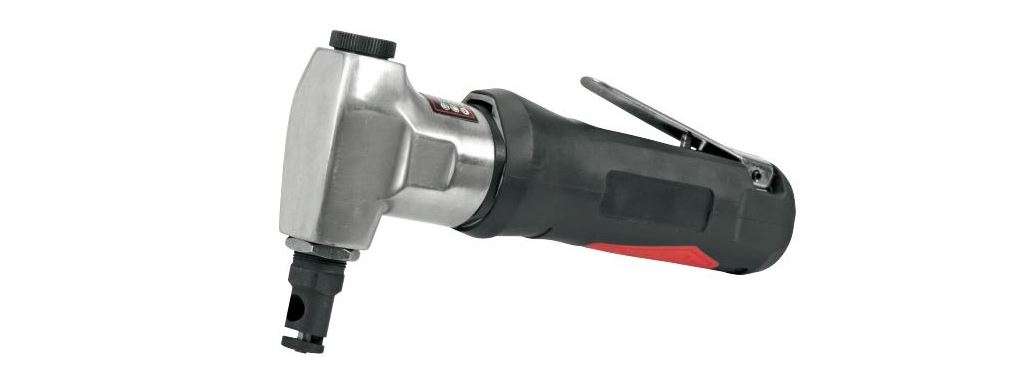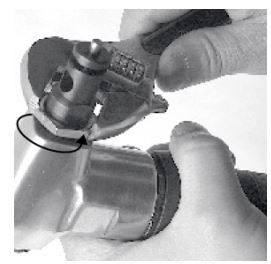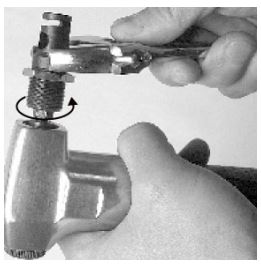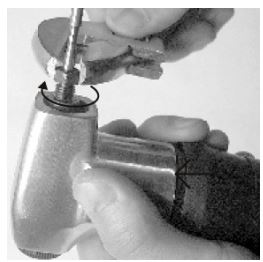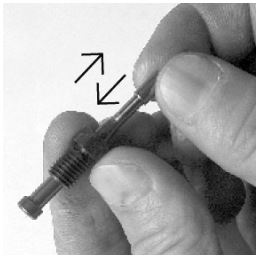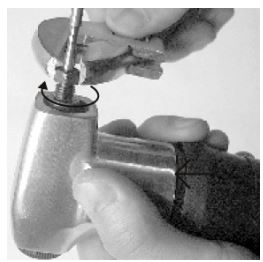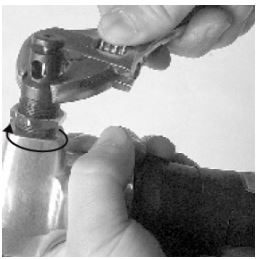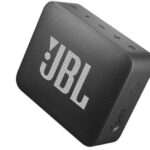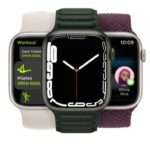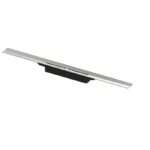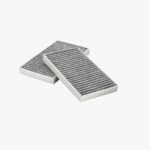MEEC TOOLS 017081 Nibbler User Manual
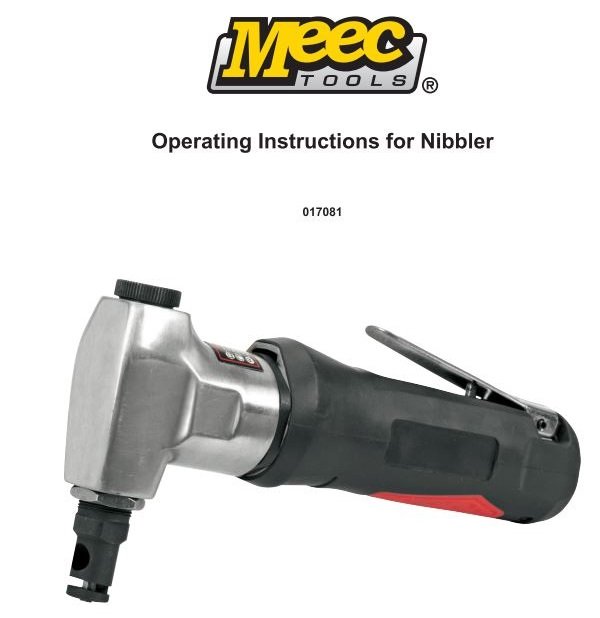
Care for the environment!
Recycle discarded product in accordance with local regulations.
Jula reserves the right to make changes. For latest version of operating instructions, see www.jula.com
![]()
![]()
![]()
EU DECLARATION OF CONFORMITY
Item number 017081
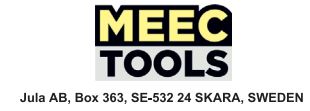
This declaration of conformity is issued under the sole responsibility of the manufacturer.
NIBBLER AT-7038 3800/min, Max air pressure: 6.3bar
Conforms to the following directives, regulations and standards:
Directive/Regulation
MD 2006/42/EC
Harmonised standard
EN ISO 11148-11:2011
This product was CE marked in year:
Skara
Bo Eriksson
BUSINESS AREA MANAGER (Signatory for Jula and authorised to compile the technical documentation.
SAFETY INSTRUCTIONS
Read the Operating Instructions carefully before use
WARNING
Incorrect usage and insufficient maintenance of the product can result in serious personal injury and/or material damage. Read all warnings and instructions carefully before use. Always take basic safety precautions when using compressed air tools to safeguard against the risk of personal injury.
- Pneumatic tools can throw out objects such as mounting pieces, metal shavings, sward, etc., at high speed, which can cause serious eye injuries. Always wear approved safety glasses with side protection.
- Never leave the tool unattended when connected to the compressed air supply. Always disconnect the air hose when the tool is not in use.
- Compressed air can be dangerous. The compressed air system can cause injury to soft tissues such as eyes, ears, etc. Particles or objects carried by the air flow can cause personal injury. For further protection, you should wear an approved face mask in addition to the eye protection.
- Tools or accessories can come loose or break, and parts can be thrown off, hitting the user or other individuals
in the work area. Check that all tools and accessories are fitted correctly. - Sanding tools with paper or discs, rotating tools such as drills, percussion tools such as nail guns, staple guns or hammers, as well as reciprocating saws and jigsaws, can generate sparks that can ignite flammable material.
- Never use tools near flammable substances such as petrol, naphtha, solvents, etc.
- The work area must be clean, well ventilated and free from flammable materials.
- Never attempt to power compressed air tools with oxygen, carbon dioxide or other bottled gas.
- Never exceed the nominal maximum pressure for tools or accessories. This can cause an explosion resulting in serious personal injury.
- The feed pressure of the compressed air supply must never exceed the maximum permitted pressure for any accessory.
- Never connect the tool to a compressed air supply whose pressure can exceed 13.8 bar.
- Always check that the compressed air supply is set to the tool’s rated pressure before connecting the tool.
- Long-term exposure to noise from compressed air tools can cause permanent hearing impairment. Always wear ear protection.
- Cutting tools and sanding tools with paper or discs generate dust and abrasive material that can be harmful to the lungs and respiratory system. Always use a close-fitting face mask or breathing mask when working with such tools.
- Some materials, such as adhesive and tar, contain chemicals that produce fumes which can cause serious injury following long-term exposure. Keep the work area clean, dry and well ventilated.
Risk of injury
- If the tool is left unattended with the air hose connected, it can be started by unauthorised individuals and cause personal injury. Always disconnect the air hose when the tool is not in use. Store the tool out of the reach of children and inexperienced individuals.
- Pneumatic tools can throw out mounting pieces or other objects. Only use parts, mounting pieces and accessories that are recommended by the manufacturer.
- Keep the work area clean.
- Keep children and onlookers at a safe distance when using the tool.
- Make sure the work area is well lit.
- Spanners or the like that are left in a rotating part of the tool can cause personal injury. Remove adjuster keys/spanners and other assembling tools before starting the power tool.
- Never use tyre filling nozzles when blow cleaning. This can cause serious injuries.
- Serious personal injury can occur if a pneumatic tool is started by mistake during maintenance or tool changing. Always disconnect the air hose before lubrication and before assembling the tool and/or accessories.
- Never carry the tool by the hose.
- Avoid accidental starting. Do not carry the tool with your finger on the trigger when the tool is connected to the compressed air supply.
- Repairs must only carried out by an authorised service centre.
- Compressed air tools can cause the workpiece to move on contact, which can result in personal injury. Secure the workpiece with clamps or similar, so that it cannot move.
- Carelessness or lack of concentration can cause you to lose control of the tool, which can result in personal injury.
- Never use compressed air tools if you are under the influence of drugs, alcohol or medication.
- Do not overreach. Always maintain a firm footing and good balance.
- Keep the handles clean, dry and free from oil and grease.
- Stay alert. Always be careful when using the equipment. Use your common sense. Do not use the tool if you are tired.
- Tools and accessories (such as grinding discs, chisels, sockets, drills, nail guns, staple guns) of a poor quality, or that are damaged or unsuitable for the purpose, can shatter during use, throwing out parts and causing serious injury.
- Only use tools and accessories that are designed for the tool’s rated speed.
- Never use tools that have been dropped, exposed to knocks or bumps, or that are damaged.
- Only use sockets that are approved for impact tools together with impact wrenches.
- Do not overload the tool. Let the tool do the work.
- Mounting pieces can be thrown out, causing serious injury or damage to property. Never point the tool’s outlet opening at yourself or at anyone else.
- Never press the trigger unless the tool’s contact safety catch is pressed against the workpiece.
- Never attempt to drive mounting pieces into hard materials such as steel, concrete or tiles/clinker.
- Never drive in a mounting piece on top of another one.
- Position the tip of the tool carefully, so that the mounting pieces are driven in at exactly the right place.
- Insufficient maintenance of tools and accessories can cause malfunctions that result in serious personal injury. Maintain the tool in good order.
- Keep cutting tools sharp and clean. Properly maintained cutting tools with sharp cutting edges are less likely to jam and are easier to control.
- Maintain the tool in good order. Keep cutting tools sharp and clean. Properly maintained cutting tools with sharp cutting edges are less likely to jam and are easier to control.
- Make sure that moving parts are properly adjusted and do not jam and that no parts are incorrectly fitted or damaged. Check for any other factors that could influence functionality.
- If the tool is damaged, it must be repaired before being used again.
- Only use accessories recommended by the manufacturer for the specific tool. Accessories that are not intended for the tool can cause personal injury.
- Loose hair, jewellery, loose-fitting clothes, etc., can become caught in tools with moving parts or that drive other moving parts (grinding discs, sockets, etc.). This can cause serious injuries. Do not wear loose-fitting clothing, ties, scarves, etc., as these can get caught in moving parts.
- Do not wear jewellery, a watch, etc. as these can get caught in moving parts.
- Always keep your hands at a safe distance from rotating parts. Tie up or cover long hair.
- Always wear suitable clothing and other protective equipment when working with the tool.
- Pneumatic tools can cause serious injuries. Keep your hands and the rest of your body away from the tool’s moving parts.
Electrical safety
- The use of pneumatic tools to secure live wires can result in electric shock and, at worst, can be fatal.
- The tool’s grip and handle are not electrically insulated. In the event of contact with a live wire, the tool’s metal parts become live and the user receives a shock which can, at worst, be fatal. Avoid body contact with earthed surfaces such as pipes, radiators, cookers and refrigerators. There is an increased risk of electric shock if your body is earthed.
- If a mounting piece comes into contact with concealed live wires, the user receives a shock which can, at worst, be fatal. Check carefully that there are no concealed electrical wires before you start work.
Other safety instructions
- Replace any warning stickers that have become illegible or lost.
- Only use the tool for its intended purpose.
- Excessive air pressure or excessively long operation without a load shortens the tool’s service life and can entail a risk of personal injury or damage to property.
- Check the air hose for wear and protect it from heat and sharp edges. Do not carry the tool by the air hose.
- Falling is a common cause of personal injury and death. Look out for hose bends in your area of movement and in the work area. Also look out for the part of the hose that is permanently connected to the tool.
- Continuous use and unsuitable working conditions can cause hand injury. Stop using the tool if your hands become numb or start to hurt. Do not resume work until your hands feel normal again. Consult a doctor immediately if the problem persists.
- Keep other people at a safe distance from the work area.
- The product may contain one or more chemical substances that have been shown to be carcinogenic, harmful to the developing foetus or to cause fertility problems. Wash your hands after use.
Compressed air supply
- Check that the relevant compressor provides sufficient air flow.
- The tool must always be turned off when it is connected to the compressed air supply.
- Normal operating air pressure for the tool is 6.2 bar. Excessively high pressure and contaminated air cause the tool to wear unreasonably quickly, and can also entail a risk of personal injury or damage to property.
- Every day, drain off any water from the compressor’s air container and empty the air hoses of any condensate that has accumulated. Otherwise, water from the air hoses can penetrate the tool and damage it.
- Clean the air intake filter cartridge each week. The chart below shows the recommended connection.
- If hoses are very long (normally longer than 8 metres), the line pressure must be increased to compensate for the pressure drop. The minimum inner diameter of the hose is 1/4″. Couplings must have the same inner diameter. An air hose with an inner diameter of 3/8″ is normally recommended for optimum tool function.
- Use appropriate hoses and couplings. We do not recommend connecting quick-release couplings directly to the tool, as they can cause malfunction as a result of vibration. Instead, connect a hose to the tool and install a quick-release coupling between the air hose from the compressor and the anti-vibration hose that is attached to the tool.
- Check each hose for wear before use. Make sure that all connections are secure.
TECHNICAL DATA
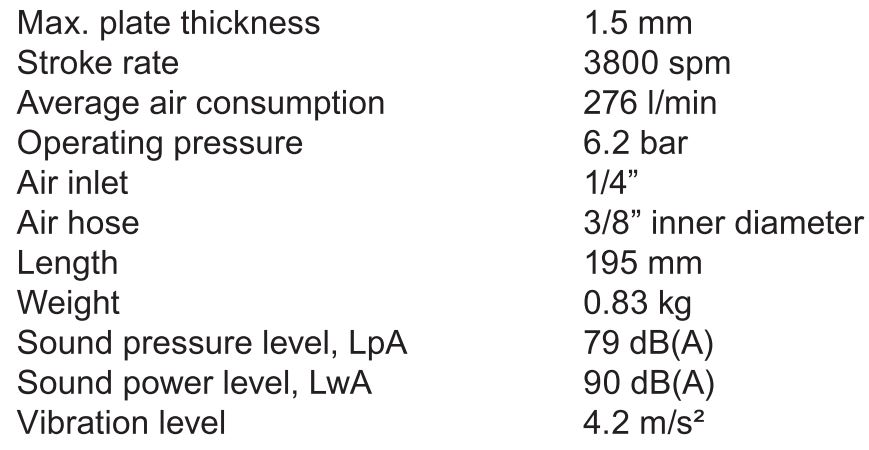
Always wear ear protection!
The declared vibration value, which has been measured by a standardised test method, can be used to compare different tools with each other and for a preliminary assessment of exposure.
WARNING The actual vibration level when using power tools may differ from the specified maximum value, depending on how the tool is used. It is therefore necessary to determine which safety precautions are required to protect the user, based on an estimate of exposure in actual operating conditions (taking into account all stages of the work cycle, e.g. the time when the tool is switched off and when it is idling, in addition to the start-up time).
USE
Configuration of the compressed air system

- Pneumatic tool
- Air hose, inner diameter 3/8″
- Lubricating device
- Pressure regulator
- Filter
- Shut-off valve
- Anti-vibration hose
- Quick-release coupling
- Drain cock (empty daily)
- Pipe and connection, min. 1/2″
- Air drier
- Pipe and connection, min. 1″
- Compressor
- Water separator
- Drain, condensate
Preparation
Check before assembly and use that all parts are available. If any part is missing or damaged, do not attempt to assemble, install or use the product. Contact your dealer to obtain replacement parts.
Using for the first time
- Lubricate the tool before use according to the instructions in the section on care and maintenance.
- Remove the cover from the air intake and fit the male connector.
- Connect the air hose to the tool. Set the working pressure to 6.2 bar for best performance.
- Press the trigger. Place the pad in the correct position to the plate that is to be cut. The pad can be adjusted and placed to the left or right, depending on the application. Release the lock nut, turn the pad and blade to the required position, and tighten the lock nut.
NOTE
Wind thread tape on the male connector and tighten with a spanner so that the connection is airtight. Do not overtighten.
Replacing the pad and blade
Disconnect the compressed air supply.
- Release the lock nut with a spanner.

- Unscrew the pad with a spanner.

- Unscrew the blade socket with the blade.

- Insert a new blade in the socket.

- Replace the blade socket and tighten it firmly.

- Replace the pad and tighten it firmly with the spanner.

- Tighten the lock nut with the spanner.
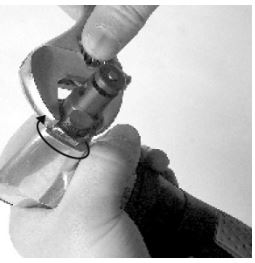
NOTE The open side of the pad should be turned forward in line with the plate to be cut.
MAINTENANCE
Lubricate the tool with compressed air oil every day, or before each use. During continuous operation, the tool must be lubricated every hour or two. The tool can be lubricated with a line-mounted lubricating device or manually. Follow the instructions below for manual lubrication.
- Connect the tool to the compressed air supply. Run the tool with no load for a few seconds to distribute the oil.
- Before putting the tool away after use, disconnect the air hose and apply 4 or 5 drops of compressed air oil in the air intake. Reconnect the air hose and run the tool for approx. 30 seconds to distribute the oil evenly. This will ensure the tool lasts longer.
- Do not store the tool in damp conditions. This can result in corrosion damage to the mechanism. Always lubricate the tool before putting it away.
NOTE:
- Do not use oil with a high viscosity. This can impair the tool’s performance.
- Any surplus oil may be ejected from the outlet. Aim the tool in a safe direction.
TROUBLESHOOTING
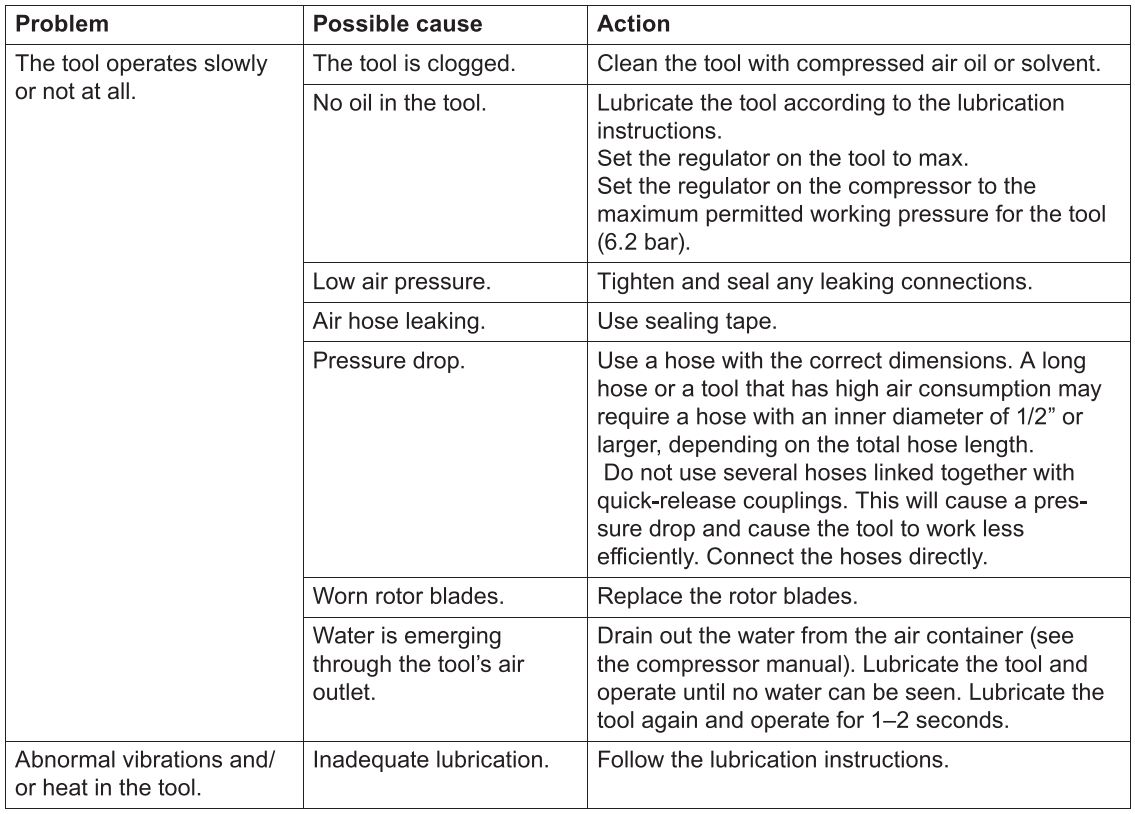
Download PDF
MEEC TOOLS 017081 Nibbler User Manual PDF Download
